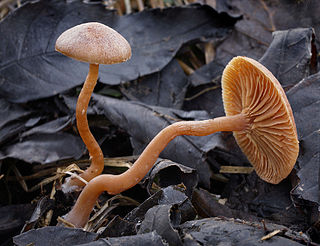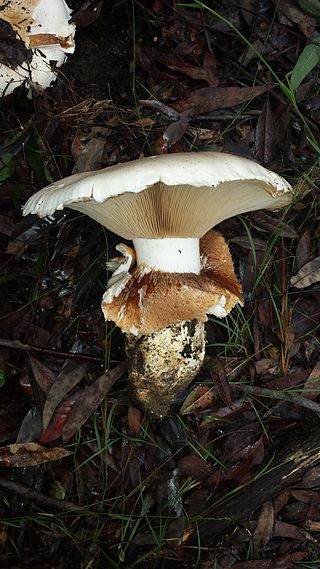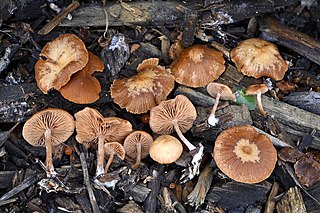
Tylopilus is a genus of over 100 species of mycorrhizal bolete fungi separated from Boletus. Its best known member is the bitter bolete, the only species found in Europe. More species are found in North America, such as the edible species T. alboater. Australia is another continent where many species are found. All members of the genus form mycorrhizal relationships with trees. Members of the genus are distinguished by their pinkish pore surfaces.

Psilocybe subaeruginosa is a species of agaric fungus in the family Hymenogastraceae described in 1927 and known from Australia and New Zealand. As a blueing member of the genus Psilocybe it contains the psychoactive compounds psilocin and psilocybin.

Cortinarius archeri is a species of mushroom in the genus Cortinarius native to Australia. The distinctive mushrooms have bright purple caps that glisten with slime, and appear in autumn in eucalypt forests.

Tubaria is a genus of fungi in the family Tubariaceae. The genus is widely distributed, especially in temperate regions. Tubaria was originally named as a subgenus of Agaricus by Worthington George Smith in 1870. Claude Casimir Gillet promoted it to generic status in 1876. The mushrooms produced by species in this genus are small- to medium-sized with caps ranging in color from pale pinkish-brown to reddish-brown, and often with remnants of the partial veil adhering to the margin. Mushrooms fruit on rotting wood, or, less frequently, in the soil. There are no species in the genus that are recommended for consumption.

Underwoodia is a genus of ascomycete fungi in the order Pezizales. The widespread genus contained many species, beforre they were transferred to the Geomorium genus. The genus, described by Charles Horton Peck in 1890, honors mycologist Lucien Marcus Underwood.

Russula persanguinea is a species of agaric fungus in the family Russulaceae. Described as new to science by John Burton Cleland in 1933, it is found in Australia, where it grows singly or in small groups on the ground in eucalypt forests and woodlands. It resembles the common Northern Hemisphere species Russula emetica.

Austropaxillus infundibuliformis is a species of fungus in the family Serpulaceae. A mycorrhizal species, it grows in the eucalypt forests of southeastern Australia. It is readily recognised by its tawny yellow colour, large size and forked decurrent gills.

Tubaria punicea is a rare species of agaric fungus in the family Tubariaceae. It is found on the west coast of North America, where it grows on the bases and in hollows of madrone.

Cuphophyllus cheelii is a species of fungus in the family Cantharellaceae. First described in 1919 by botanists John Burton Cleland and Edwin Cheel, the fungus is found in Australia.
Russula erumpens is a species of fungus in the family Russulaceae. It is found in Australia, where it occurs in eucalypt forests and woodlands.
Melanoleuca abutyracea is a species of fungus in the family Pluteaceae. Found in Australia, it was first described scientifically in 1931 by John Burton Cleland as a species of Collybia. Mycologist Cheryl Grgurinovic transferred it to Melanoleuca in 2002.

Austrocortinarius australiensis, commonly known as the skirt webcap, is a species of mushroom in the family Cortinariaceae which is native to Australia and New Zealand. The white mushrooms appear in autumn and can grow very large, with their caps reaching 30 cm (12 in) in diameter.

Cortinarius erythraeus, sometimes known as the Jammie Dodger, is a basidiomycete fungus of the genus Cortinarius native to Australia.
Hygrophoropsis psammophila is a species of fungus in the family Hygrophoropsidaceae. Originally described by John Burton Cleland in 1933 as Paxillus psammophilus, it was transferred to the genus Hygrophoropsis by Cheryl Grgurinovic in 1997. It is found in Australia, where it grows in groups in sand.

Tubaria furfuracea, commonly known as the scurfy twiglet or totally tedious tubaria, is a common species of agaric fungus in the family Tubariaceae. It was first described by Christiaan Hendrik Persoon in 1801 as a species of Agaricus. French mycologist Claude-Casimir Gillet transferred it to the genus Tubaria in 1876.
Cortinarius microarcheri is a basidiomycete fungus of the genus Cortinarius native to South and Western Australia, where it grows under Eucalyptus.

Phlegmacium lavendulense is a species of fungus in the family Cortinariaceae.

Cortinarius sublargus is a species of fungus in the family Cortinariaceae native to Australia. It was described in 1928 by John Burton Cleland from the Mount Lofty Ranges. Cleland also described Cortinarius radicatus in 1933 from material collected in Willunga Hill, Waitpinga, Mount Lofty, Mount Compass, and Kinchina, Though Cleland regarded them as distinct, later authorities determined them to be the same species. The latter name turned out to be a homonym, having already been given to a different species.

Mycena albidocapillaris is a species of mushroom in the family Mycenaceae that is found in Australia. It was first described scientifically in 1933 by mycologist John Burton Cleland, who named it Mycena subcapillaris. The type collection was made in 1922 on Mount Lofty. It was later discovered that the name was invalid, as Paul Hennings use of that name in 1899 took precedence. Cheryl Grgurinovic and Tom May republished the species with the new replacement name Mycena albidocapillaris in 1997.

Crepidotus affinis is a species of saprophytic fungus in the family Crepidotaceae with a stipeless sessile cap. The fungus was described by Egon Horak in 2018 and has been found in New Zealand, Panama, and the Philippines.
















